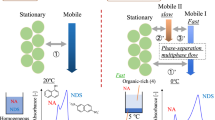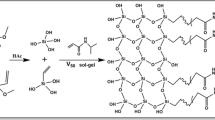Abstract
The vapor condensation method can be used for forming an alternative flow of liquid masses using a single solvent for alternative plugs flow liquid chromatography (APFLC), described in our previous paper. APFLC is more effective when adopting a T-shaped flow path and aqueous-organic solvents with a liquid-to-gas volume ratio (bulk fraction; ß) ranging between 0.0006 and 0.004 in an open tubular GC capillary column at below 70°C. High-density plugs flow by a T-shaped flow path leads to extremely high resolution. Alternative plugs flow is formed when the liquid contact angle to the solid phase is above 75°. An aqueous mixture of the usual HPLC solvent can be readily used for APFLC. An EI-mass spectrum is obtained that is comparable with that in the NIST library, except for the DMF mixture medium. Due to low-pressure loss properties in the column, the system does not require a high-pressure liquid pump. Solid hydrocarbon resin with a contact angle to water of between 75° and 79°, such as polystyrene and olefinic polymers, is anticipated to be applicable to APFLC and hydro-membrane gas chromatography (HMGC) by a consideration of their surface tensions.
Similar content being viewed by others
References
I. Tanikawa, N. Hirakawa, H. Hosono, and H. Nakamura, Anal. Sci., 2007, 23, 1267.
I. Tanikawa, M. Konuma, H. Hosono, and H. Nakamura, Anal. Sci., 2009, 25, 743.
E. A. Grulke, in “Polymer Handbook”, 4th ed., 1999, John Wiley & Sons, New York, 6758.
JIS K 6768, “Plastics—Film and Sheeting—Determination of Wetting Tension”, 1999, Japanese Industrial Standards Committee, Tokyo.
M. Imoto, “Hyomen Choryoku no Rikai no Tameni (For an Understanding of the Surface Tension, in Japanese)”, 1993, Kobunshi Kanko Kai, Kyoto, 73.
“Wettability Technology Hand Book/Fundamentals· Measurement Valuation Data”, 2001, Techno-System, Tokyo.
A. W. Adamson, “Physical Chemistry of Surfaces”, 6th ed., 1997, Wiley Interscience.
“Kagaku Binran (Chemical Handbook, in Japanese)”, 5th ed., 2004, Maruzen Tokyo, II-92.
“Purasuchikku De-ta Handobukku (Handbook of Plastics, in Japanese)”, 1999, Asahikasei Amidas Corporation.
“Puraschikku Seikei Kakou De-ta Bukku (Data-Book for Forming of Plastics, in Japanese)”, ed. The Japan Society for Technology of Plasticity, 1988, Nikkan Kogyo Shinbunsha, Tokyo, 12.
“Kouseinou Ekijyou Porima (High Quality Liquid Polymer Materials, in Japanese)”, ed. The Society of Polymer Science, Japan, 1990, Maruzen, Tokyo, 136.
“Shirikon Handobukku (Silicone Handbook, in Japanese)”, ed. K. Ito, 1990, Nikkan Kogyo Shinbunsha.
E. A. Grulke, in “Polymer Handbook”, 4th ed., 1999, John Wiley & Sons, New York, 688.
“Saishin Koubunshi ni yoru Hyoumen Kinou Sekkei (Design of Surface Function for Latest Polymers, in Japanese)”, ed. The Society of Polymer Science, Japan, 2003, NTS, 87.
Y. Kitazaki and T. Hata, J. Adhes. Soc. Jpn., 1972, 8, 131.
T. Tsuda, “Kagaku-semina-15 Kuromatogurafi—Bunri no Shikumi to Oyo (Chromatography-Mechanism of Separation and Applications, in Japanese)”, 1989, Maruzen, Tokyo, 43.
C. A. Cramers, in Proceeding of the Fifth International Symposium on Capillary Chromatography, 1983, Riva der Garda, 82.
“Kagaku Binran (Chemical Handbook, in Japanese)”, 4th ed., 1978, Maruzen Tokyo.
“Ki Eki Nisouryu Gijyutu Handobukku (Handbook of Two-Phase Flow Chromatography, in Japanese)”, ed. Japanese Association of Machinery, 1989, Corona Publishing, Tokyo, 248 and 272.
Author information
Authors and Affiliations
Corresponding author
Rights and permissions
About this article
Cite this article
Tanikawa, I., Konuma, M., Hosono, H. et al. Alternative Plugs Flow Liquid Chromatography (APFLC)/EI-MS System Using a T-shaped Flow Path. ANAL. SCI. 27, 95–99 (2011). https://doi.org/10.2116/analsci.27.95
Received:
Accepted:
Published:
Issue Date:
DOI: https://doi.org/10.2116/analsci.27.95




